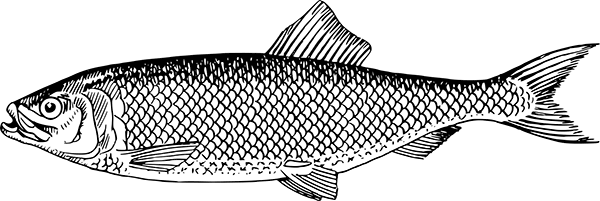An account of the herring’s life cycle, its eight identified stages and a brief history of the development of that classification
LIFE CYCLE
Larval, Juvenile and Adult Herrings
Newly hatched, the herring larvae are between 6 and 8 mm long, at first, depending on reserves in the yolk sac. Hatched in aquaria, they stay at the bottom until roughly four days old, although this hasn’t been confirmed by studies in natural conditions.
They develop mouths in this early period and swim to the surface. Until they reach 45 mm, at around three months, they have a thin, eel-like appearance and are not strong enough to swim against the predominating current.
Like the zooplankton they feed on, they can drift considerable distances to their nursery grounds: Murman herring are carried from the Lofoten Islands to the Barents Sea, Downs herring to the German Bight, Buchan herring sometimes to the Norwegian and Danish coasts and the Skagerrak.
Where the currents are more localised, as with many of the small coastal populations, the journeys are much shorter.
The number of vertebrae is affected by water temperature during the larval stage, the colder the water the higher the count becomes. This obviously helps to determine some of the differences between local forms, but can also be noticeable between year groups in the same population.
Scales appear as they change from larvae to juveniles (between 3 and 5 cm). At 5 cm, able to swim more strongly, they begin to form shoals and move inshore, mixing with young sprats and, together with them, are fished as whitebait, once wrongly thought of as the separate species Clupea alba.
At the end of the first year (up to 8 cm), they move offshore. By the end of the second year they reach between 13 and 18 cm. They fatten in the third year and, in the southern North Sea, become sexually mature in the fourth, the maturing virgins leaving the shoals of young fish to join adult spawning shoals.
Oceanic herrings become mature at between five and eight years old. Avoiding the fisherman’s nets and other predators, herrings live approximately 12 years.
The Eight Ages of the Herring
The Norwegian expert Hjort came up with seven (st)ages of the herring, which is more in keeping with the Shakespearean dimensions of the fish (see Battle of the Herrings and Pickelherring), but, in 1962, a Herring Committee Working Group of ICES (the International Council for the Exploration of the Sea) recommended the adoption an eight stage scale, classifying the maturities of their subject. It was called the Bergen Scale, because it had been drawn up previously by the Atlanto-Scandian Working Group, who had met in that city. It is, however, largely based on classifications originally proposed by Heincke (see Racial Theory) and Johansen.
I Virgin herring: very small, thread like gonads, 2 – 3 mm across (wine red ovaries; whitish to grey brown testes).
II Virgin herring with small sexual organs: ovaries (bright red) and testes (reddish-grey) 3 – 8 mm in height; eggs visible with a magnifying glass.
III Filling herring with gonads occupying about half the ventral cavity: sexual organs 1 – 2 cm across; eggs small but visible to naked eye; orange ovaries and reddish-grey or greyish testes.
IV Filling herring with gonads almost as long as body cavity: opaque eggs larger but varying in size; orange or pale yellow ovaries and whitish testes.
V Full herring: gonads fill body cavity; large, round eggs (some transparent); yellowish ovaries and milk white testes; eggs and sperm do not flow, but sperm (milt) can be extruded through the application of pressure.
VI Spawning herring: transparent eggs; white testes; free-flowing eggs and sperm.
VII Spent herring: baggy, bloodshot gonads; empty ovaries and testes (or containing only residual eggs or the remains of sperm).
VIII Recovering spents: wine-red gonads firmer and larger than Stage II with striated walls and prominent blood vessels; eggs not visible to naked eye.
Stage VIII stage passes into Stage III again and so the cycle continues. If the herring manages to avoid the fisherman’s net and its various natural predators, it can repeat the annual cycle several times: the year class from a highly successful Norwegian spawning in 1904 still represented 1.5% of the catch in 1927.
Virgin full herrings and completely recovered spents with a good fat content are known as maatjes, not entirely to be confused with the Scottish matties (gutted and cured herring, 9″, maturing) and matfulls (gutted and cured herring, 9¼”, full of milt or roe).
